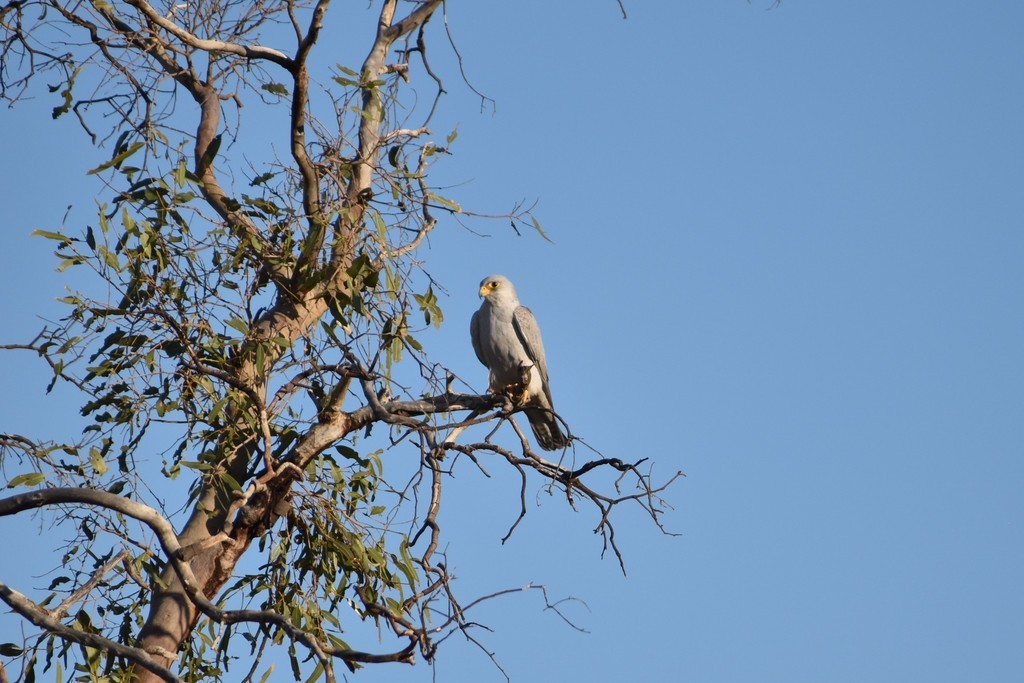Grey Falcon
A species of True Falcons Scientific name : Falco hypoleucos Genus : True Falcons
Grey Falcon, A species of True Falcons
Botanical name: Falco hypoleucos
Genus: True Falcons
Content
Description General Info
 Photo By tim_nickholds , used under CC-BY-NC-4.0 /Cropped and compressed from original
Photo By tim_nickholds , used under CC-BY-NC-4.0 /Cropped and compressed from original Description
The species has mainly grey upperparts and white underparts, darker on the tips of the flight feathers and with a yellow cere. Young birds are darker. Adults have a body length of 30–45 cm and a wingspan of 85–95 cm, and weight 350–600 g. Females are larger. The call of the grey falcon consists of hoarse chattering, clucking and whining sounds, similar to the peregrine falcon but slower and deeper. Calls include a loud, slow "kek-kek-kek" or "kak-ak-ak-ak". Both of the collectors of Gould's specimens were effusive in their praise of this falcon's appearance, Sturt's field note says it had a "delicate beauty", and when Gilbert obtained his second specimen in August 1842 he wrote, I assure you I never gazed with more delight on any Specimen I ever Shot, than on this Bird, as it lay in the grass, throwing up its feet to prevent my hand reaching it. 
Size
43 cm
Nest Placement
Tree
Feeding Habits
Grey Falcon primarily preys on birds (88%), including flocking ground-feeders like parrots and pigeons, but also eats small mammals (6%), reptiles (5%), and invertebrates (1%). They usually feed on the ground, often near bores, showcasing distinctive hunting and feeding behavior in open arid environments.
Habitat
The grey Falcon primarily inhabits arid and semi-arid regions characterized by woodland, scrub, savannas, dunes, and plains. It shows a preference for timbered lowland plains, with a particular affinity for acacia shrublands interspersed with tree-lined watercourses. This species is likely to be found in grassland and other types of woodland habitat as well, where it nests in riparian woodlands of arid zones.
Dite type
Carnivorous
General Info
Feeding Habits
Bird food type
Distribution Area
The grey falcon is an Australian endemic, usually confined to the arid inland. It inhabits Triodia grassland, Acacia shrubland, and lightly timbered arid woodland. It has been sighted over most of mainland Australia except for Cape York. Very few have been seen on the Nullarbor Plain and in the Great Victoria, Gibson and Great Sandy Deserts. Most sightings of the grey falcon have been within the arid zones, with annual rainfall less than 500 mm. When they have been occasionally seen outside of these areas, they have been found in similar dry, low altitude, open woodland or grassland. The only times this bird has been seen in different conditions has been along the Queensland coast during drought years. The grey falcon is often seen in family-type groups of an adult pair and usually one (but up to four) first year birds. In Sturt's notes to his 1845 contribution to Gould's set of specimens, collected at the interior of New South Wales, he commented that the pair were the only individuals to be seen in their seventeen-month exploration of the region. The grey falcon is possibly the rarest of the Australian falcons, and may also have been historically uncommon. 
Species Status
The species has very low densities, numbering only 1,000 breeding pairs, but the population may be stable. Continued high levels of grazing in arid zone rangelands and clearance of the semi-arid zone for marginal farming is degrading habitat. 
Scientific Classification
Phylum
Chordates Class
Birds Order
Diurnal Birds of Prey Family
Falcons and caracaras Genus
True Falcons Species
Grey Falcon